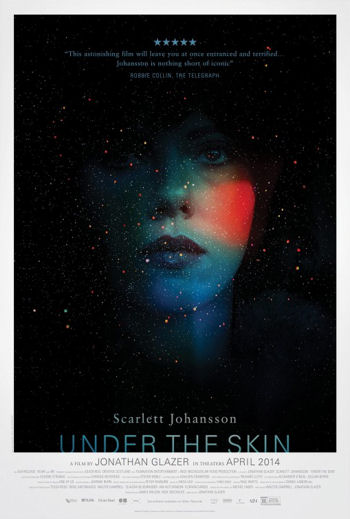|
Under The Skin
A decade ago, director Jonathan Glazer (2000's Sexy Beast) released his last film, Birth, starring Nicole Kidman, which received mixed reviews – initially. The film would eventually earn some respect after additional viewings, generating something of a cult status.
I predict the same fate for his latest film, Under the Skin, a psychological sci-fi thriller starring Scarlett Johansson. Although an extraordinary original film, one that both respects and challenges its audience, there will be some who will be too perplexed and frustrated to fully appreciate it. At first.
The best way to view and experience this unique film is to know next to nothing going in. You may hear or read information about this movie, but the less you know the better you're off. That's why I'm gonna skimp through the details of exceptional story, an adaptation of Michael Faber's 2000 novel of the same name.
Under the Skin takes place in modern-day Scotland, where a mysterious woman (Johansson) roams the countryside at night in a white van picking up lone young men off the street. In tight blue jeans, a fur coat and ink black hair, the attractive pale-skinned woman is an alluring presence. She offers small talk with each passenger, asking them whether or not they are married or have children, what they do for a living and where they're heading. At no point does she give away any information about herself, relying on her tantalizing sexuality, drawing them in with the promise of her developing interest in them.
What we witness so far is intriguing enough and becomes gradually more unsettling as the woman's activity progresses. It's unsettling because we don't know who she is or what she's about, but also because we can tell there's more going on than what these men think (or want) will happen.
 Glazer closes in on the woman's observations – of the men she picks up and the world around her. It's as if she's on an assignment, observing her surroundings from the perspective of an outsider, an alien.
The real mystery is what transpires outside of her van. Glazer closes in on the woman's observations – of the men she picks up and the world around her. It's as if she's on an assignment, observing her surroundings from the perspective of an outsider, an alien.
The real mystery is what transpires outside of her van.
That's where things get really trippy, quite disturbing and downright surreal. Glazer shows us where she leads these men. Her victims. Inside the different buildings she lures them into, we enter the same indistinct room, void of color. A black place where they become entranced and disappear. Forever. She's far from the woman they think she is, despite the object of desire she appears to be.
Just as mysterious as this woman is her motorcycle man, her accomplice (or accomplices?), who follows her various pick-ups, making sure no trace of her activity can be discovered. He acts more like a cleaner than he does a pimp.
From its beginning, Under the Skin establishes itself as an abstract film, one that calls upon our senses to figure out what we see and hear moving around on the screen. Glazer incorporates the haunting aural combination of composer Mica Levi and sound designer Johnnie Burn to his work of art. With its audible scratches and industrial noises, they've created an ambient soundtrack that's a character all its own, and one that's just as hard to figure out as the events we follow. What we hear is as unnerving as the woman Johansson portrays, yet just as captivating.
 It’s an element as prominent as the versatile approach cinematographer Daniel Landin brings to the film. In the first hour of the film,the camera follows the woman’s interactions with her pedestrians, in a jittery guerilla style similar to a voyeur. Despite the confining interior of van’s cabin, Glazer and Landin manage to create a distance between the woman and the men by emphasizing the awkwardness of the encounters. Whether it’s a focus on fidgety fingers or the appropriately placed silent moments of the script by Walter Campbell and Glazer, the level of discomfort becomes an absorbing slow burn. It’s an element as prominent as the versatile approach cinematographer Daniel Landin brings to the film. In the first hour of the film,the camera follows the woman’s interactions with her pedestrians, in a jittery guerilla style similar to a voyeur. Despite the confining interior of van’s cabin, Glazer and Landin manage to create a distance between the woman and the men by emphasizing the awkwardness of the encounters. Whether it’s a focus on fidgety fingers or the appropriately placed silent moments of the script by Walter Campbell and Glazer, the level of discomfort becomes an absorbing slow burn.
Outside the van, there are other moments that further build on the detached coldness established between the woman and her environment. One particularly haunting scene is set on a rocky shoreline where the woman witnesses a tragic event occur. We watch what transpires from a distance, because the woman has positioned herself as an observer who evokes zero emotion. She just stands and watches from afar. It’s a scene that confirms this woman as someone who is both frightening and curious. The only thing that stands out amongst the cool palette is Johansson’s red lips.
Johansson is quite remarkable as this nomadic seductress. Her dialogue is seldom, which finds the evocative actress relying on body language and behavior to develop her character. She may seem like a blank slate at first, but her character actually has an arc to follow. Johansson provides subtle changes as the story unfolds, moving the woman from chilling confidence to confusion and insecurity. It’s a challenging and thoughtful performance that flips Johansson’s celebrity gaze on its head, spinning her attractiveness by giving viewers a Maneater. The second half of the film finds the woman embarking on a path of discovery, detouring from her pattern, that leads to a revelatory encounter in the Scottish wilderness.
 There are two other characters in Under the Skin who serve as catalysts in their own right for the woman. The first is one of several non-actors used in the film, the other is an actor less familiar to audiences as Johansson is. Both play an integral part in the woman’s journey and self-discovery. There are two other characters in Under the Skin who serve as catalysts in their own right for the woman. The first is one of several non-actors used in the film, the other is an actor less familiar to audiences as Johansson is. Both play an integral part in the woman’s journey and self-discovery.
This is Johansson’s film to carry though and she does so in an exquisite way. Under the Skin may come to be known as That Movie Where Scarlett Johansson Gets Naked – which is inevitable and unfortunate. Her nudity is in the shadows, less titillating than it is an anatomical study that continues her discovery.
Glazer leaves the audiences with many questions. Asking them to determine what this woman is about and where she is from, more importantly what she is. That may be frustrating for some, but I found it refreshing. Here is a rare adaptation that is far from the source material, finding Glazer using the novel as a template as he creates an otherworldly aura (both in tone and locations) around the main character. The director’s approach can be compared to that of Kubrick or Tarkovsky, maybe even Cronenberg, but Glazer has nevertheless established an unforgettable style all his own at the same time.
To say any more would be to rob you of experiencing this fascinating film on your own. I’ve purposefully been as vague as possible. Its images linger long after viewing. It poses questions that warrant in-depth discussion, touching on themes of objectification and loneliness. It is also one of the most captivating films so far this year. If it’s been a while since you’ve found yourself taking in a film that feels new and mesmerizing, look no further than Under the Skin.
|

 Glazer closes in on the woman's observations – of the men she picks up and the world around her. It's as if she's on an assignment, observing her surroundings from the perspective of an outsider, an alien.
The real mystery is what transpires outside of her van.
Glazer closes in on the woman's observations – of the men she picks up and the world around her. It's as if she's on an assignment, observing her surroundings from the perspective of an outsider, an alien.
The real mystery is what transpires outside of her van.  It’s an element as prominent as the versatile approach cinematographer Daniel Landin brings to the film. In the first hour of the film,the camera follows the woman’s interactions with her pedestrians, in a jittery guerilla style similar to a voyeur. Despite the confining interior of van’s cabin, Glazer and Landin manage to create a distance between the woman and the men by emphasizing the awkwardness of the encounters. Whether it’s a focus on fidgety fingers or the appropriately placed silent moments of the script by Walter Campbell and Glazer, the level of discomfort becomes an absorbing slow burn.
It’s an element as prominent as the versatile approach cinematographer Daniel Landin brings to the film. In the first hour of the film,the camera follows the woman’s interactions with her pedestrians, in a jittery guerilla style similar to a voyeur. Despite the confining interior of van’s cabin, Glazer and Landin manage to create a distance between the woman and the men by emphasizing the awkwardness of the encounters. Whether it’s a focus on fidgety fingers or the appropriately placed silent moments of the script by Walter Campbell and Glazer, the level of discomfort becomes an absorbing slow burn. There are two other characters in Under the Skin who serve as catalysts in their own right for the woman. The first is one of several non-actors used in the film, the other is an actor less familiar to audiences as Johansson is. Both play an integral part in the woman’s journey and self-discovery.
There are two other characters in Under the Skin who serve as catalysts in their own right for the woman. The first is one of several non-actors used in the film, the other is an actor less familiar to audiences as Johansson is. Both play an integral part in the woman’s journey and self-discovery. 




